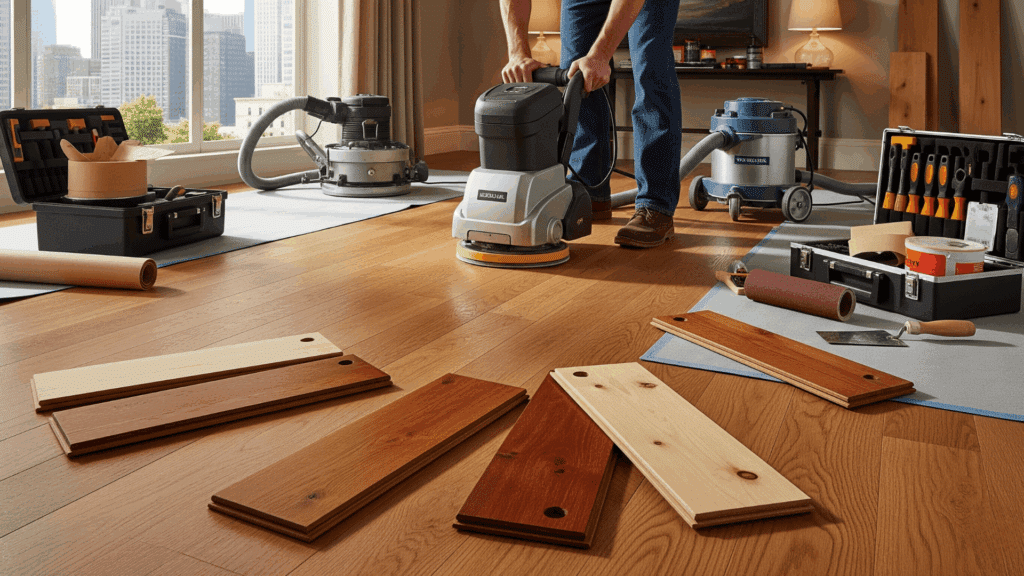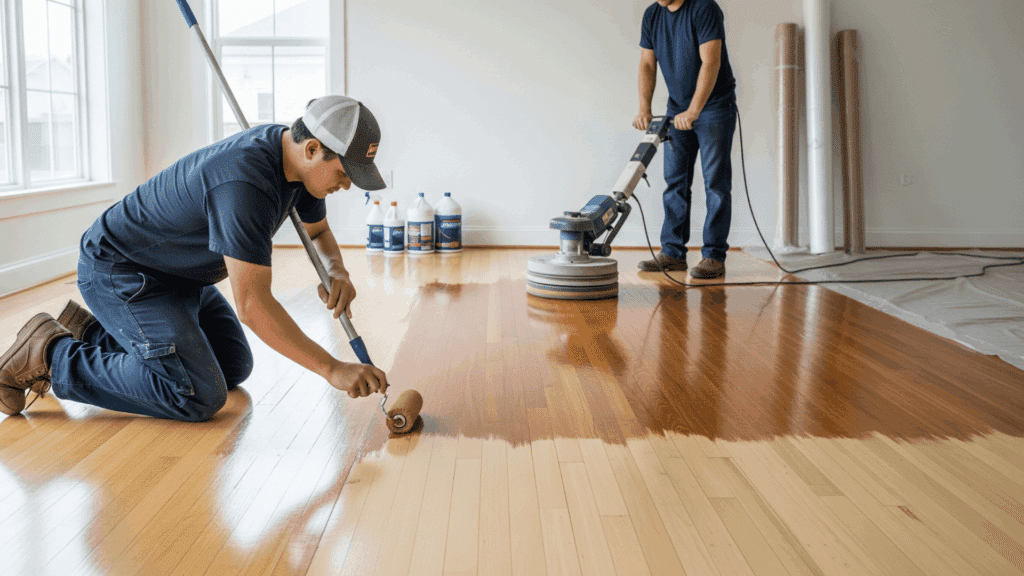When I thought about updating my floors, I realized refinishing is a budget-friendly way to restore worn hardwood. It brings back the natural look by removing scratches and dullness while protecting the wood.
Understanding the cost to refinish hardwood floors helped me weigh options without surprises. Knowing the hardwood floor refinishing cost also guided my choice between refinishing and full replacement.
Keeping the floors in good shape with refinishing not only improves how the space feels but also protects my investment, making refinishing hardwood floors a smart step toward long-lasting, attractive flooring.
Cost Averages for Refinishing Hardwood Floors
The average refinishing hardwood floors cost typically ranges between $3 and $8 per square foot, with the total project often around $1,800.
Several factors influence the price, including the size of the area, wood type, and refinishing method. Labor generally accounts for the majority of the cost, given the preparation and sanding required.
Denser woods and more complex materials may increase expenses. Larger spaces might benefit from volume discounts, while additional repairs or dustless refinishing can raise the price.
Overall, refinishing remains a cost-effective way to restore beauty and durability to hardwood flooring.
Cost Per Square Foot Breakdown for Hardwood Floor Refinish
Understanding the price per square foot helps plan your hardwood refinishing project effectively:
| Type / Approach | Cost per Sq. Ft. | Notes |
|---|---|---|
| Professional Refinishing | $3 – $8 | Includes labor, equipment, and materials |
| DIY Project | $2 – $4 | Lower cost, but requires tools and time |
| Softwoods | $1 – $3 | Less dense, easier to refinish |
| Hardwoods | $2 – $5 | Varies by species and condition |
| Exotic Woods | $5 – $10 | Extra care and specialized methods are needed |
Knowing these general ranges helps you budget wisely and choose the best approach for your flooring needs.
Factors Influencing the Cost to Refinish Hardwood Floors

Understanding the key variables that impact refinishing expenses helps homeowners budget effectively and make informed decisions about their flooring projects.
These factors can significantly affect the final cost, ranging from material choices to geographic location:
1. Wood Type and Species Selection
The type of hardwood significantly influences refinishing costs, with different species requiring varying levels of care and materials.
Oak and cherry typically cost $3–$5 per square foot to refinish, representing more affordable options due to their common availability and straightforward refinishing process.
Premium woods like maple and mahogany can cost up to $8 per square foot because they need specialized techniques, higher-grade finishes, and careful handling to preserve their natural beauty and grain patterns.
2. Project Scope and Size Considerations
Larger refinishing projects often benefit from economies of scale, resulting in lower per-square-foot costs as fixed expenses are distributed across a larger area.
Projects covering 1,000 square feet typically range from $3,000–$10,000 total, depending on wood type and condition. Contractors can optimize equipment usage, material purchasing, and labor efficiency on bigger jobs, making substantial projects more cost-effective per unit.
However, smaller spaces may incur higher per-square-foot rates due to minimum service charges and setup costs.
3. Geographic Location and Market Variability
Regional differences in labor costs, material availability, and local market conditions create significant price variations across different areas.
Boston exemplifies high-cost markets with refinishing rates ranging $4–$9 per square foot, driven by expensive labor, older homes requiring specialized techniques, and higher living costs.
Urban areas typically command premium pricing compared to rural regions, while areas with abundant local lumber sources may offer more competitive material costs, affecting overall project expenses.
4. Refinishing Method and Technique Choice
The chosen refinishing approach substantially impacts both cost and project timeline, with traditional and dustless methods offering different value propositions.
Traditional hardwood floor refinishing costs $3–$8 per square foot and involves standard sanding equipment, while dustless refinishing ranges $5–$8 per square foot using specialized vacuum-integrated systems.
Dustless methods decrease cleanup and household disruption but are costlier due to premium equipment and expertise, despite providing better convenience and air quality benefits during refinishing.
5. Damage Assessment and Repair Requirements
Pre-existing floor damage significantly increases refinishing costs beyond standard surface preparation and finishing work.
Deep scratches, gouges, water damage, or structural issues require extensive repairs, including floorboard replacement and potential subfloor work. These repairs can double or triple base refinishing costs, depending on severity and extent.
Professional assessment is crucial to identify hidden damage like subfloor rot or structural weakness that may not be apparent initially but will require addressing during the refinishing process.
DIY vs. Professional Hardwood Floor Refinishing
Choosing between DIY and professional refinishing depends on your budget, skill level, and time availability. Here is how both of these approaches compare:
| Aspect | DIY Approach | Professional Service |
|---|---|---|
| Cost | Lower cost, equipment rental required | Higher cost, includes labor and equipment |
| Skill & Time | Requires skill development and significant time | Expert skill, efficient completion |
| Equipment | Must rent specialized tools | Professional-grade equipment provided |
| Dust Control | Basic containment with rental gear | Advanced dust containment systems |
| Quality | Results vary with experience | Consistent professional results |
| Warranty | No coverage | Warranties on labor and materials |
Note: DIY saves money but demands time and skill investment. Professional services cost more but guarantee quality results with warranties and efficient completion.
Hardwood Floor Alternative & Supplemental Options

When hardwood floors show signs of wear but don’t need full refinishing, alternative methods like recoating or buffing offer cost-effective ways to refresh their appearance.
These options extend the life of your floors while reducing time, mess, and expense compared to traditional refinishing.
Recoating (No Sanding)
Recoating is a less invasive and more affordable option for dull or lightly worn hardwood floors. It involves cleaning, buffing, and applying a new finish on top of the existing one, typically costing around $2 per square foot.
This method is much cheaper than the cost of full refinishing hardwood floors, which usually ranges from $10 to $12 per square foot. Recoating is quick and effective for restoring shine without sanding, but it is best for floors without deep damage or discoloration.
Buffing/Screen & Recoat
Buffing or screen and recoat provides a light refresh by polishing the old finish and applying a new topcoat. This process costs around $1 to $2.50 per square foot and is ideal for floors with minor scratches or wear.
It extends the life of your hardwood surface between full refinishing jobs while keeping downtime and costs low.
Cost Comparison: Refinishing vs. Replacement
Refinishing hardwood floors typically costs between $1,100 and $2,700, making it a more budget-friendly option for restoring floors that are still in good condition.
This process involves sanding the surface, repairing minor damages, and applying a fresh finish, which extends the floor’s lifespan and refreshes its appearance.
On the other hand, replacing hardwood floors usually costs significantly more, ranging from $2,500 to $6,800, as it involves removing the old flooring and installing new materials.
While replacement offers a completely new look and solution for damaged floors, refinishing is often the more cost-effective choice that still boosts home value and beauty.
Cost-Saving Tips & Best Practices
If your hardwood floors don’t need a full refinishing, there are simpler and more budget-friendly options to consider. These alternatives help maintain your floors’ appearance and extend their life with less time, cost, and disruption:
- Bundle larger areas for bulk pricing to reduce overall cost.
- Choose traditional sanding over dustless methods depending on your budget and cleanliness priorities.
- Handle prep work yourself, like removing carpet and clearing the room, to save on labor fees.
- Get multiple quotes to compare pricing, inclusions, and services for the best deal.
- Schedule refinishing during off-peak seasons when contractors may offer lower rates.
These tips can help maximize value, reduce expenses, and ensure a smoother refinishing project.
Conclusion
Refinishing my hardwood floors has been a worthwhile investment that refreshed my home’s look without the high cost of replacement.
It gave the floors new life, making the space feel warmer and more inviting while preserving their natural beauty. Knowing the cost to refinish hardwood floors helped me see how budget-friendly this option can be compared to new installation.
I learned that proper preparation and choosing the right finish make all the difference in long-lasting results. If considering your own project, weigh the benefits of refinishing against replacement carefully, and don’t hesitate to seek professional advice.
Ready to improve your floors? Take the first step and start planning your refinishing project today!














